In the vast and varied landscapes of New Mexico, a diverse array of hawks soar through the skies, enriching the region’s natural tapestry.
These avian predators, with their unique characteristics and behaviours, contribute significantly to the state’s ecosystems.
From the iconic Bald Eagle to the agile American Kestrel, each hawk species plays a distinct role in maintaining the delicate balance of nature.
This exploration will delve into the fascinating lives of 12 hawks in New Mexico, shedding light on their habitats, hunting strategies, and the ongoing conservation efforts essential for their survival.
Join us on a journey through the southwestern skies as we unravel the mysteries and marvels of these magnificent birds of prey. Stay sharp.
12 Hawks in New Mexico
Find out the diverse avian wonders of New Mexico as we delve into the lives of four captivating raptors.
From the iconic Bald Eagle to the agile American Kestrel, each bird brings its unique charm and ecological importance to the enchanting landscapes of the Land of Enchantment.
Explore their habitats, behaviours, and ongoing conservation efforts that ensure their continued presence.
1. Cooper’s Hawk
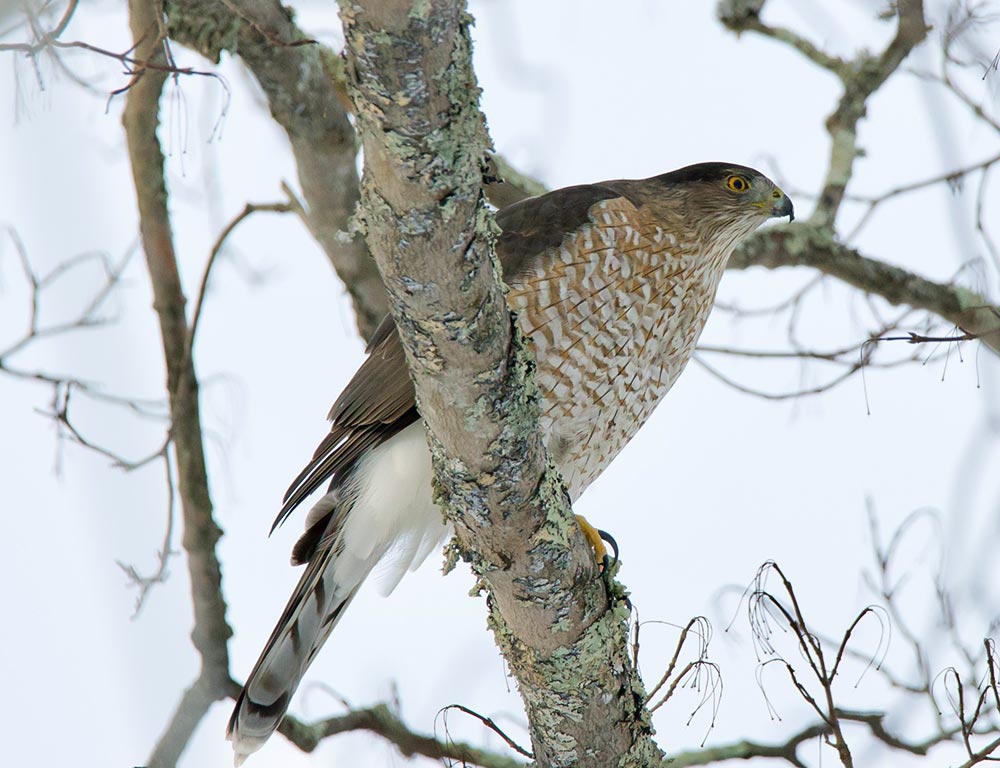
- Scientific name: Accipiter cooperii
- Population: Fairly common
- Life span: 7-10 years
- Size: 14-20 inches
- Weight: 0.5-1.5 pounds
- Food: Primarily birds, occasionally small mammals
- Wingspan: 24-35 inches
The Cooper’s Hawk is a medium-sized bird of prey found in New Mexico. These hawks are adept hunters, often navigating dense forests and suburban areas with agility.
With distinctive dark caps and reddish barred underparts, they are known for their remarkable speed and sharp vision.
They are specialized in catching birds mid-flight, using their short wings and long tails for quick, precise manoeuvres.
Cooper’s Hawks are known to have a 7 to 10-year lifespan. They build stick nests high in trees and lay 3-5 eggs per clutch.
Their population is stable, and they adapt well to various environments. Cooper’s Hawks are crucial in controlling bird populations and helping maintain ecological balance.
2. Northern Goshawk
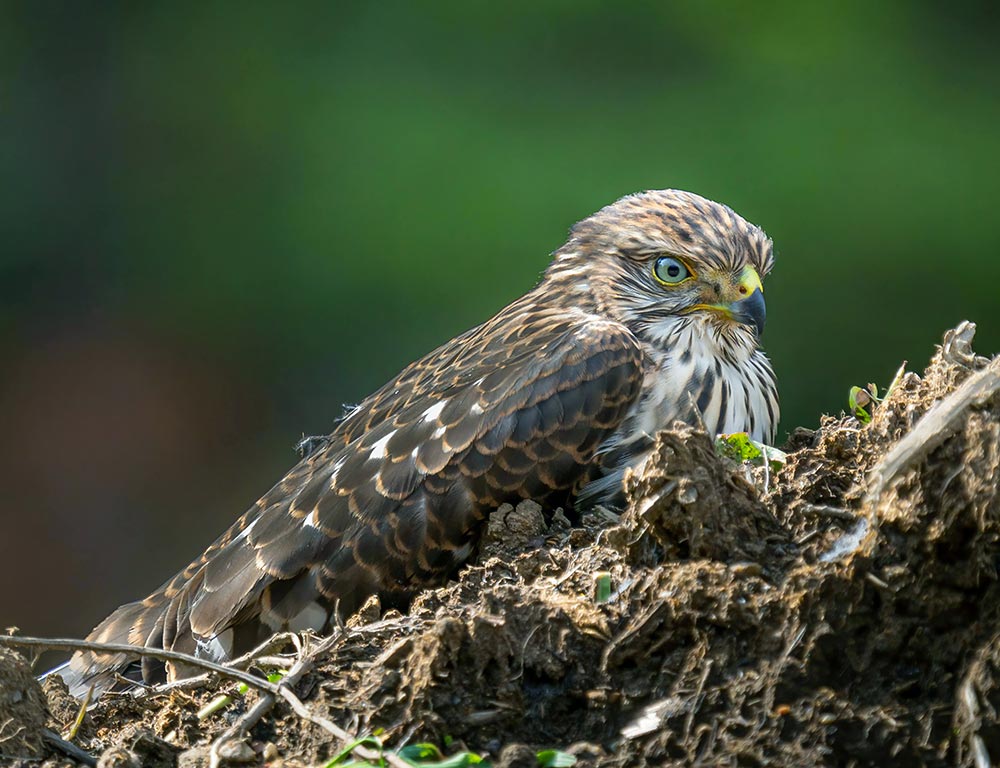
- Scientific name: Accipiter gentilis
- Population: Sparse and localized
- Life span: 8-14 years
- Size: 20-26 inches
- Weight: 1.5-3.5 pounds
- Food: Birds and mammals
- Wingspan: 40-46 inches
The Northern Goshawk, with its powerful build and striking markings, is a raptor of northern forests, including parts of New Mexico.
Known for their aggressive nature during breeding season, they are formidable hunters. Goshawks are characterized by their gray plumage and bold eye stripes.
With a lifespan of 8 to 14 years, they have a relatively long presence in the ecosystem.
Goshawks construct nests in coniferous trees and typically lay 2-4 eggs. They are skilled at hunting in densely wooded areas, preying on birds and mammals alike.
Due to habitat loss, their population is sparse and localized, making them a species of concern for conservationists.
3. Swainson’s Hawk
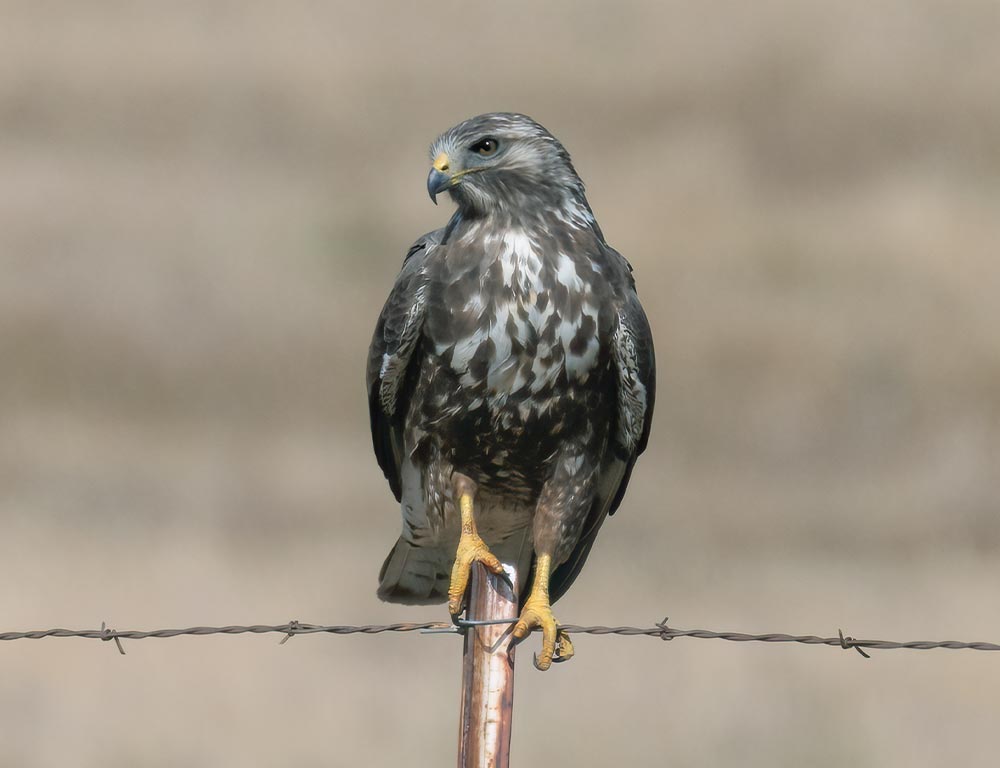
- Scientific name: Buteo swainsoni
- Population: Abundant during breeding season
- Life span: 5-8 years
- Size: 18-22 inches
- Weight: 1.5-2.5 pounds
- Food: Insects, small mammals, and reptiles
- Wingspan: 45-52 inches
Swainson’s Hawks are migratory raptors that visit New Mexico during their breeding season. With a distinctive two-toned appearance, they have a dark head and light underparts.
These hawks have a lifespan of 5 to 8 years and play a vital role in pest control by feeding on insects.
Swainson’s Hawks construct nests on trees or utility poles during the breeding season. They lay 2-4 eggs per clutch. Known for their long-distance migration, they travel to South America for the winter.
Swainson’s Hawks are abundant during their breeding season, contributing to the region’s ecological balance.
4. Gray Hawk
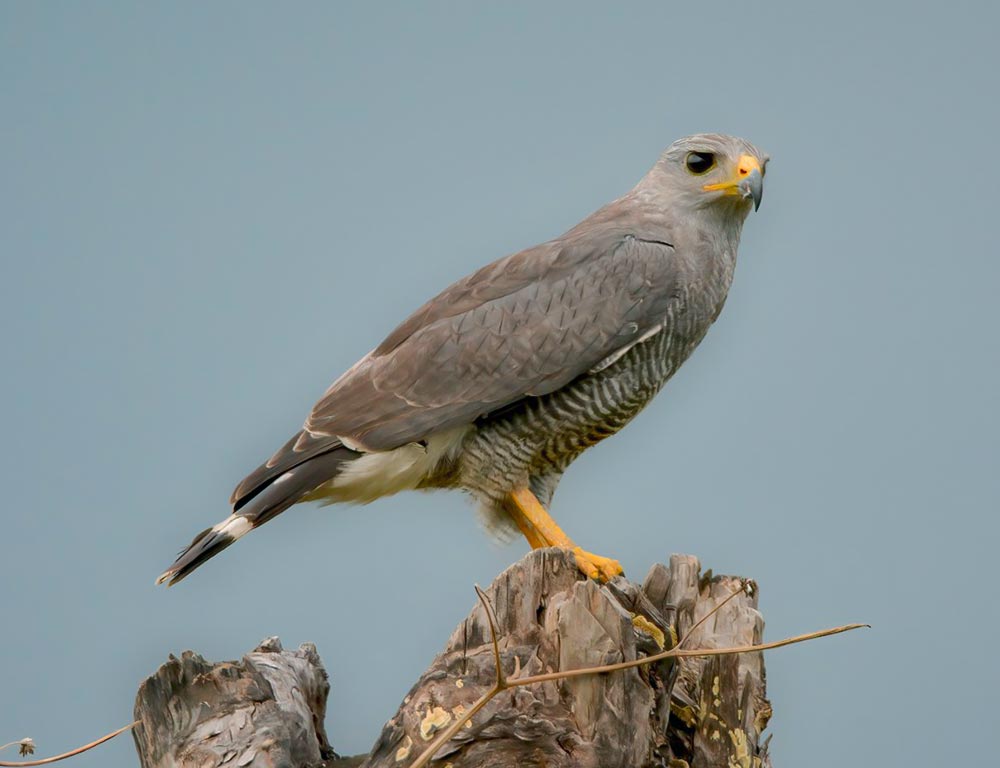
- Scientific name: Buteo plagiatus
- Population: Localized
- Life span: 10-15 years
- Size: 16-18 inches
- Weight: 1-2 pounds
- Food: Small mammals, birds, reptiles, and insects
- Wingspan: 35-40 inches
The Gray Hawk is a resident bird in certain areas of New Mexico, primarily found along riparian habitats.
These hawks have a striking grey colouration with a rufous-barred tail. With a lifespan of 10 to 15 years, they are relatively long-lived.
Gray Hawks build nests in trees near water and lay 2-3 eggs per clutch. They are opportunistic hunters, preying on small mammals, birds, reptiles, and insects.
Due to their localized population, conservation efforts are crucial to ensure the preservation of their habitats.
5. Rough-legged Buzzard
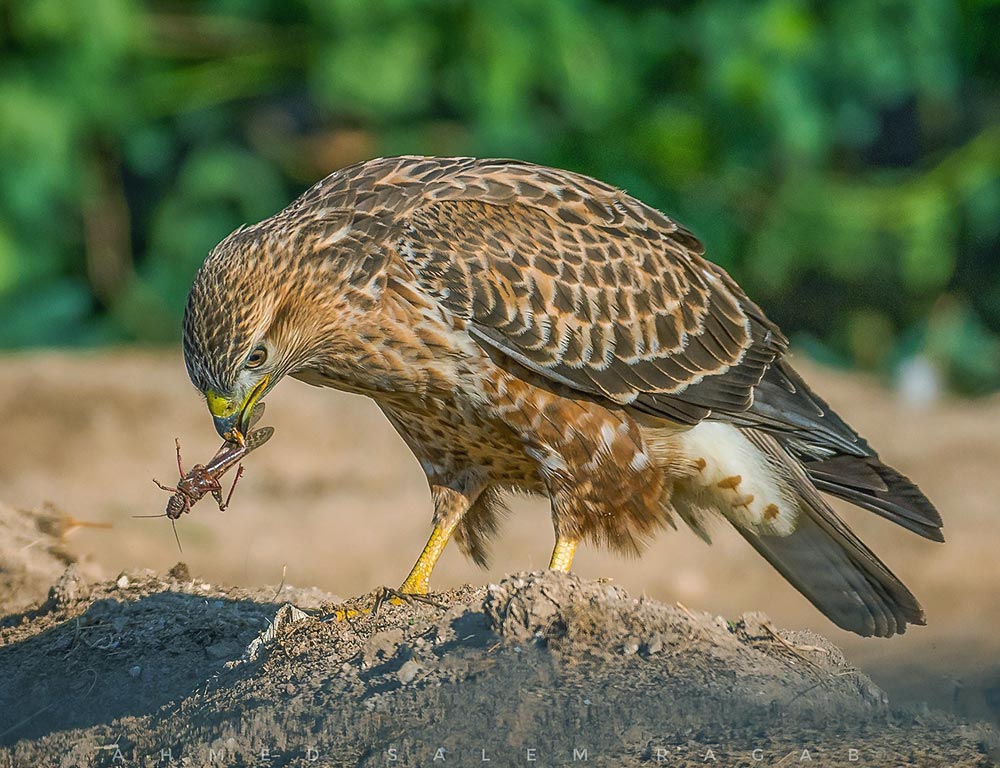
- Scientific name: Buteo lagopus
- Population: Irregular winter visitor
- Life span: 10-15 years
- Size: 18-24 inches
- Weight: 2-4 pounds
- Food: Small mammals, birds
- Wingspan: 52-54 inches
The Rough-legged Buzzard is a winter visitor to certain parts of New Mexico, migrating from its Arctic breeding grounds.
With distinctive feathered legs extending to their feet, these hawks are well-adapted to cold climates.
Their population in New Mexico is irregular, and they are known for their habit of hovering over open fields while hunting.
Rough-legged Buzzards have a relatively long lifespan of 10 to 15 years. They construct nests on cliffs or elevated areas, laying 3-5 eggs per clutch.
Their diet mainly consists of small mammals and birds. Conservation efforts are important to protect their wintering grounds and migration routes.
6. Ferruginous Hawk
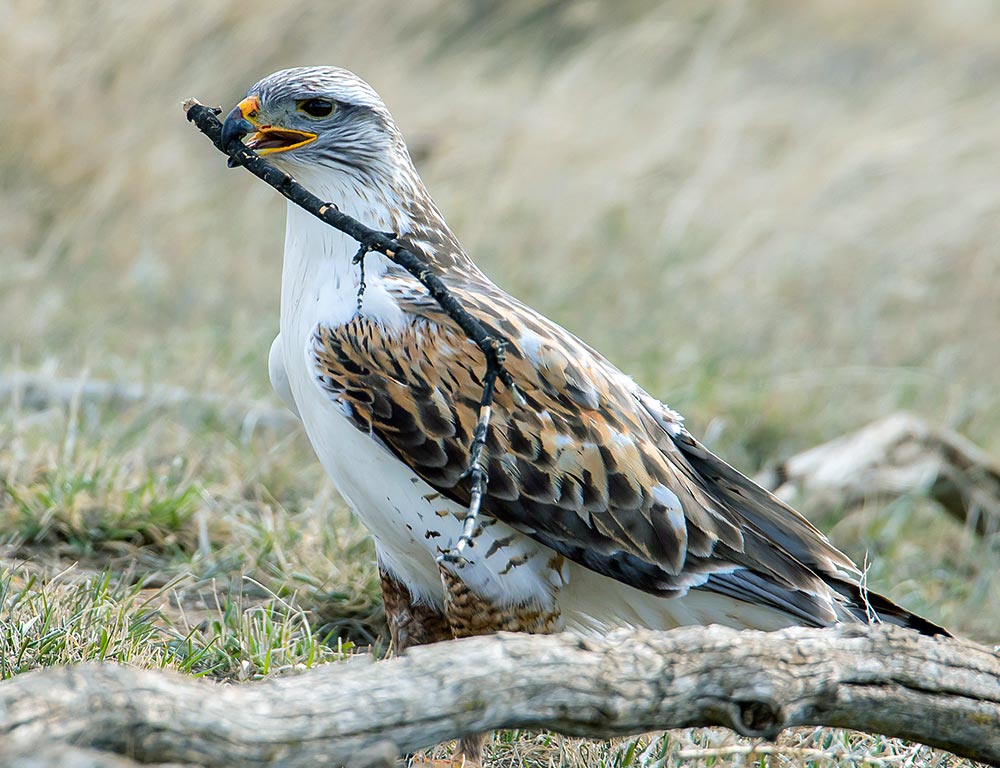
- Scientific name: Buteo regalis
- Population: Stable
- Life span: 10-20 years
- Size: 22-27 inches
- Weight: 2.5-5.5 pounds
- Food: Small mammals, ground squirrels, rabbits
- Wingspan: 49-65 inches
The Ferruginous Hawk is a large, broad-winged bird of prey found in New Mexico’s grasslands and deserts.
Identified by their light colouration and feathered legs, these hawks are powerful hunters, preying on ground-dwelling mammals. They have a stable population and are known for their adaptability to various habitats.
Ferruginous Hawks construct large nests on cliffs or trees, laying 2-5 eggs per clutch.
With a lifespan of 10 to 20 years, they play a crucial role in controlling rodent populations. Conservation efforts focus on maintaining their habitat and protecting nesting sites.
7. Common Black Hawk
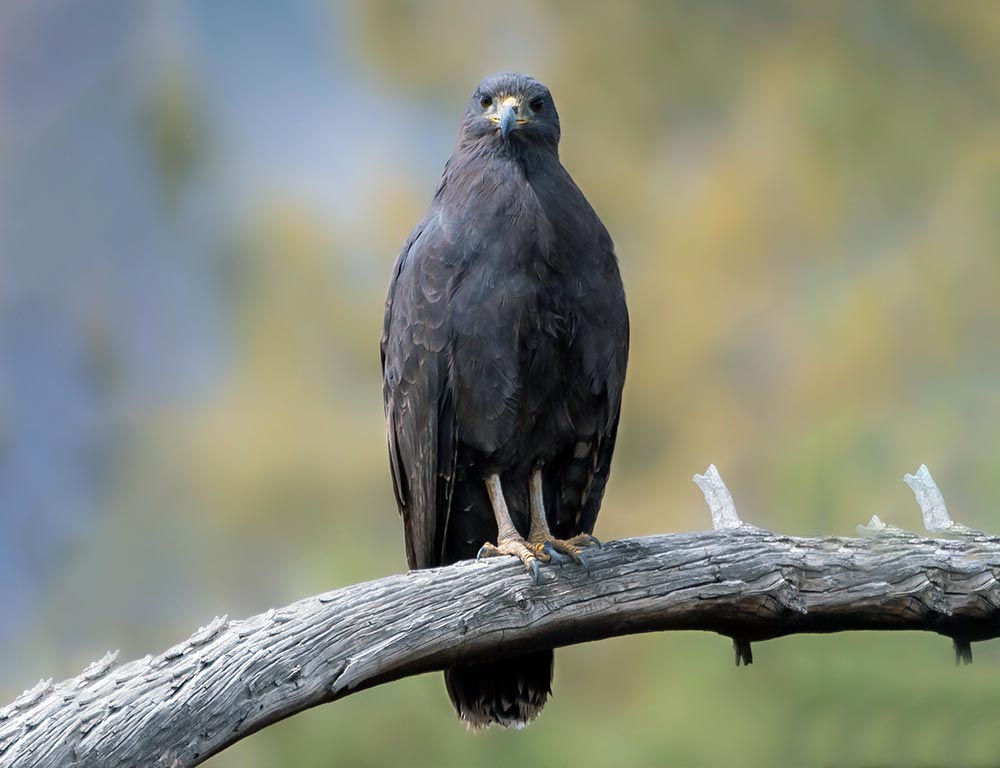
- Scientific name: Buteogallus anthracinus
- Population: Localized
- Life span: 10-15 years
- Size: 18-22 inches
- Weight: 1.5-2 pounds
- Food: Fish, small mammals, birds
- Wingspan: 35-40 inches
The Common Black Hawk is a resident bird found in riparian habitats of southern New Mexico. These hawks are skilled fishers recognized by its dark plumage and distinctive call.
Their population is localized, making them a species of concern for conservation.
Common Black Hawks construct nests in trees near water, laying 2-3 eggs per clutch. They feed on fish, small mammals, and birds, displaying a unique hunting behavior compared to other hawks.
Conservation efforts aim to protect their nesting sites and maintain healthy riparian ecosystems.
8. Northern Harrier
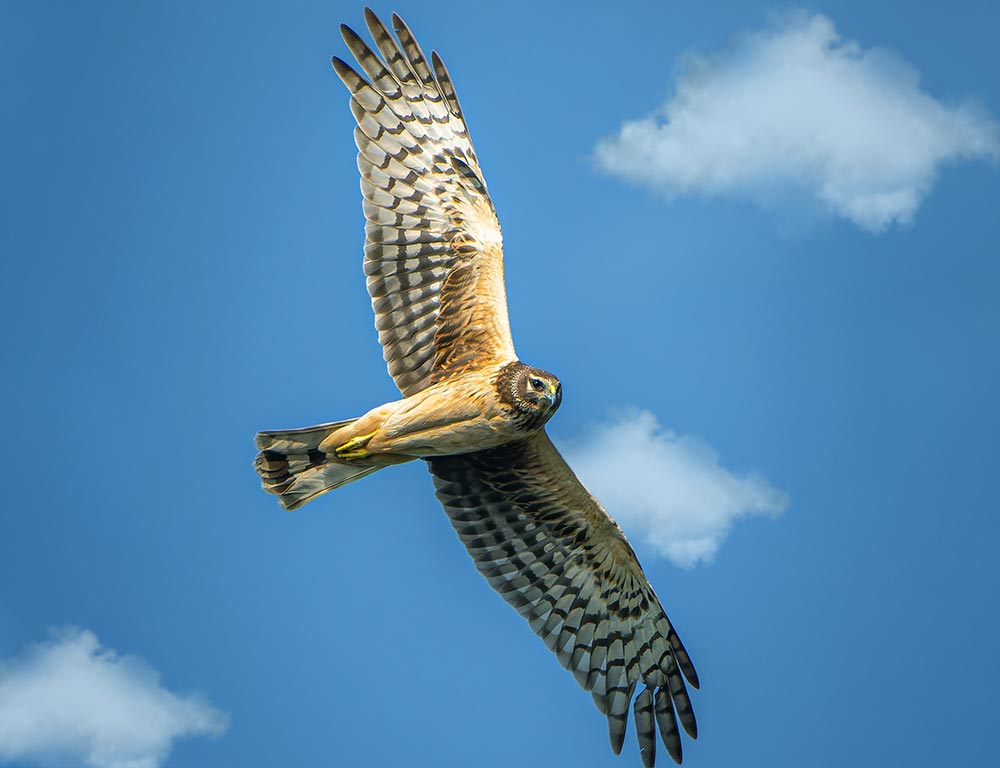
- Scientific name: Circus hudsonius
- Population: Common
- Life span: 4-8 years
- Size: 18-20 inches
- Weight: 10-26 ounces
- Food: Small mammals, birds, reptiles
- Wingspan: 40-48 inches
The Northern Harrier, often known as the “marsh hawk,” is a common raptor found in various habitats, including grasslands and wetlands in New Mexico.
Recognized by their distinctive facial disk and low flight over open areas, these hawks are agile hunters.
Northern Harriers build nests on the ground, laying 3-6 eggs per clutch. With a lifespan of 4 to 8 years, they are known for their owl-like facial features and hunting behavior.
Their diet includes small mammals, birds, and reptiles. Conservation efforts focus on preserving their diverse habitats and maintaining healthy ecosystems.
9. Bald Eagle
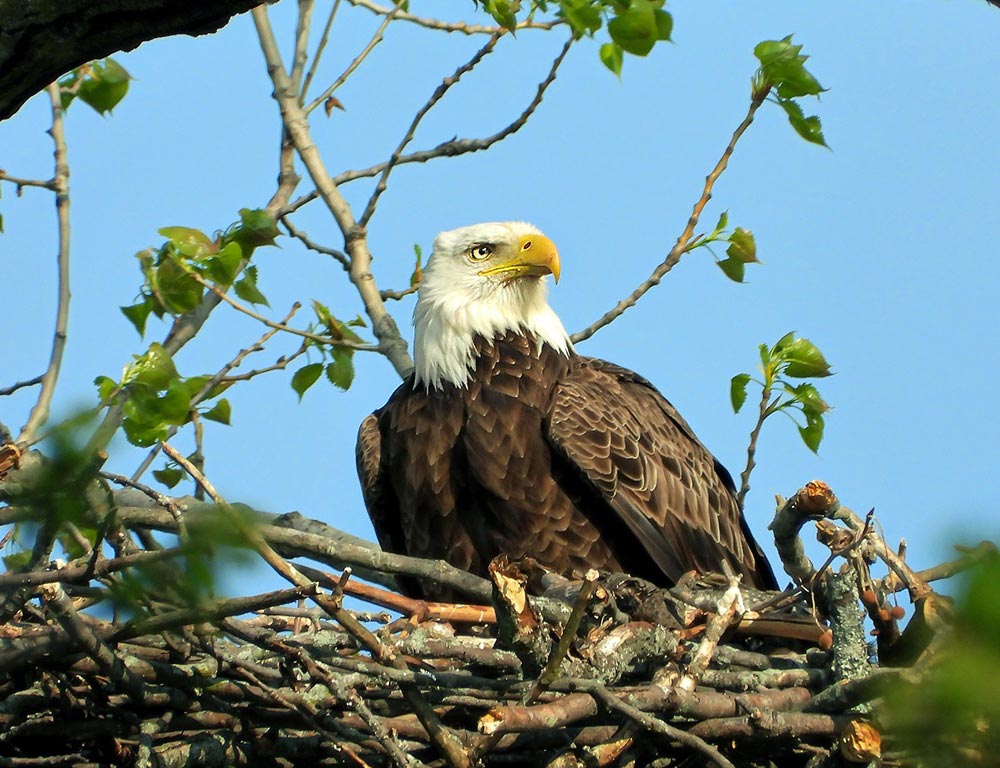
- Scientific name: Haliaeetus leucocephalus
- Population: Increasing
- Life span: 20-30 years
- Size: 28-40 inches
- Weight: 6.5-14 pounds
- Food: Fish, waterfowl, small mammals
- Wingspan: 6.5-7.5 feet
The Bald Eagle, with its distinctive white head and tail, is an iconic bird of prey and the national bird and symbol of the United States.
In New Mexico, they are commonly found near large bodies of water. The population of Bald Eagles has been increasing due to conservation efforts and the ban on the pesticide DDT.
Bald Eagles build large nests, often in tall trees near water, and lay 1-3 eggs per clutch. They have a remarkable lifespan of 20 to 30 years.
Known for their preference for fish, they are also opportunistic feeders, consuming waterfowl and small mammals. Conservation measures continue to protect their habitats and ensure the health of their prey species.
10. Mississippi Kite
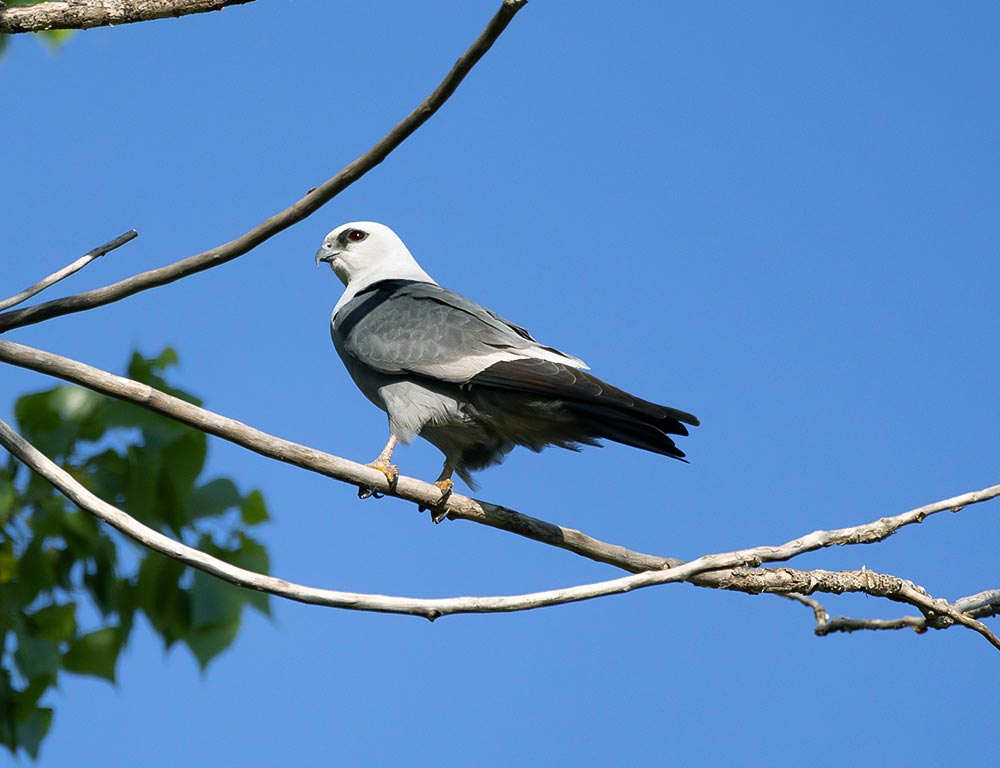
- Scientific name: Ictinia mississippiensis
- Population: Declining
- Life span: 7-10 years
- Size: 12-15 inches
- Weight: 6-12 ounces
- Food: Insects, small birds
- Wingspan: 24-30 inches
The Mississippi Kite is a graceful, medium-sized hawk that migrates to New Mexico during the breeding season.
Recognized by their striking black and white plumage, they are known for their aerial acrobatics while hunting. Unfortunately, their population is declining, making them a species of concern for conservation.
Mississippi Kites build nests in tall trees and lay 1-3 eggs per clutch. They primarily feed on insects and occasionally small birds.
Conservation efforts are crucial to address habitat loss and protect their breeding areas, ensuring their continued presence in New Mexico.
11. American Kestrel
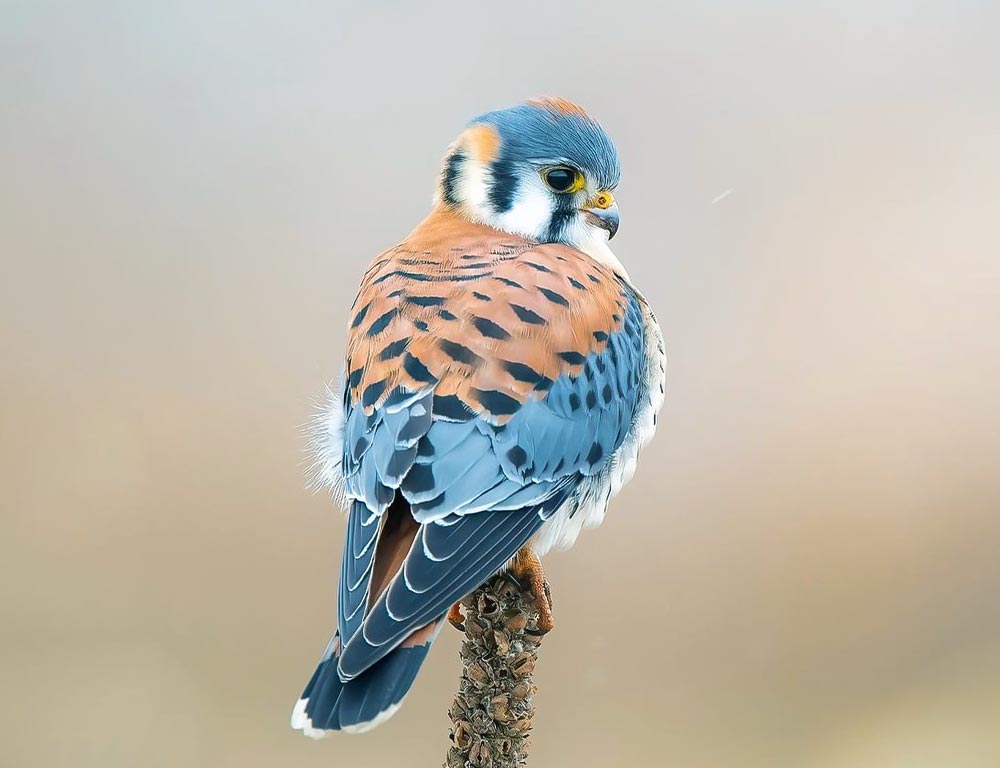
- Scientific name: Falco sparverius
- Population: Stable
- Life span: 5-10 years
- Size: 8-12 inches
- Weight: 3-6 ounces
- Food: Insects, small mammals, birds
- Wingspan: 20-24 inches
The American Kestrel, the smallest falcon in North America, is a common and adaptable bird of prey found throughout New Mexico.
Identified by their colourful plumage and hovering flight, they are often seen perched on utility wires or poles. The population of American Kestrels is generally stable.
American Kestrels nest in cavities or use abandoned nests, laying 4-5 eggs per clutch. They have a relatively short lifespan of 5 to 10 years.
These falcons are versatile hunters, preying on insects, small mammals, and birds. Conservation efforts focus on providing suitable nesting sites and protecting open habitats.
12. Golden Eagle
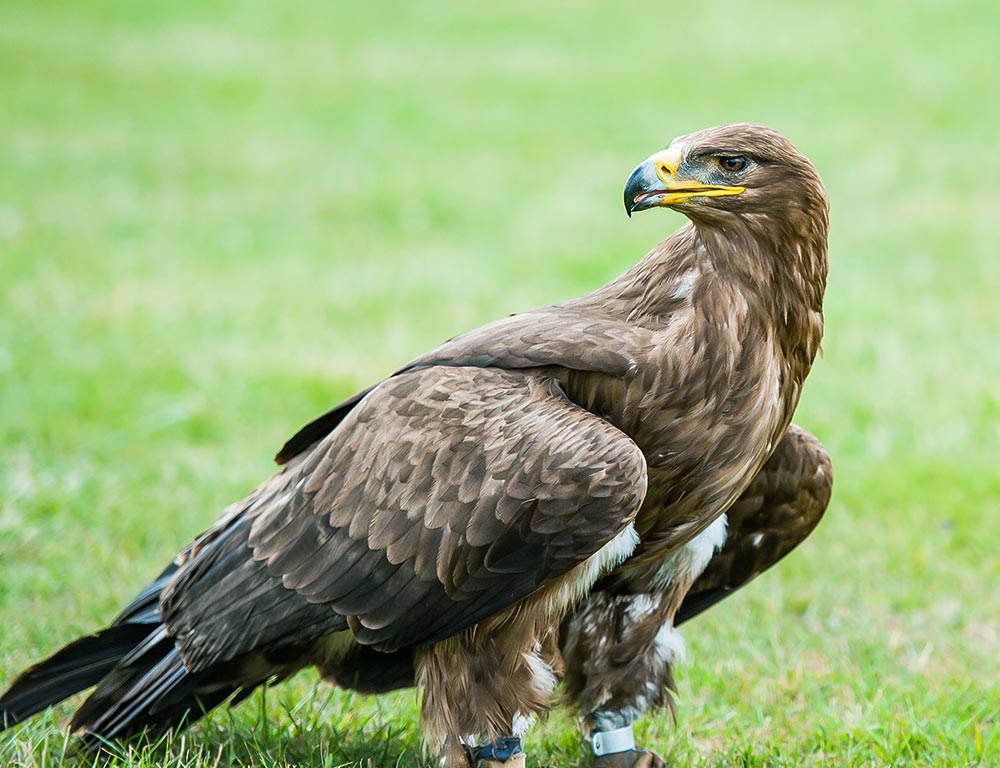
- Scientific name: Aquila chrysaetos
- Population: Stable
- Life span: 20-30 years
- Size: 27-33 inches
- Weight: 6-15 pounds
- Food: Small to medium-sized mammals, birds
- Wingspan: 6-7 feet
The Golden Eagle is a majestic raptor with dark brown plumage and a distinctive golden nape.
In New Mexico, they are found in various habitats, including mountains and open landscapes. The population of Golden Eagles is generally stable.
Golden Eagles build large nests on cliffs or high ledges and lay 1-3 eggs per clutch.
They have an impressive lifespan of 20 to 30 years. These eagles are powerful hunters, preying on small to medium-sized mammals and birds.
Conservation efforts are important to address threats such as habitat fragmentation and ensure the long-term survival of Golden Eagles in the region.
Wrapping Up
The hawks of New Mexico contribute immeasurably to the state’s ecological tapestry. Each species, from the majestic Golden Eagle to the elusive Swainson’s Hawk, plays a vital role in maintaining balance within its habitat.
Conservation efforts are paramount to safeguard these birds and their ecosystems, ensuring a harmonious coexistence with nature.
As we marvel at the diverse lifestyles and behaviours of Cooper’s Hawks, Northern Goshawks, Swainson’s Hawks, American Kestrels, Mississippi Kites, and more, let us remain committed to preserving their habitats.
It also secures a thriving future for these magnificent creatures in the heart of New Mexico. Best of luck.